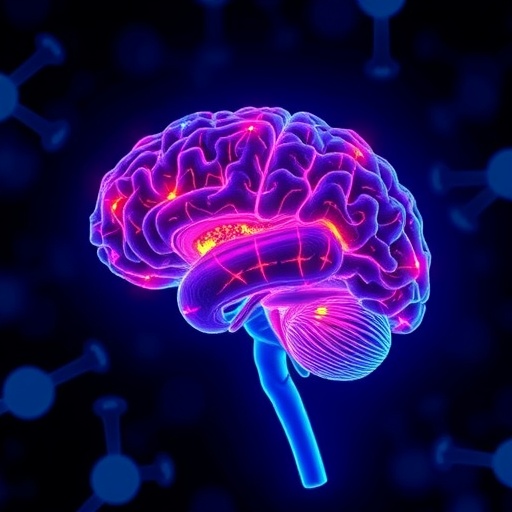In a groundbreaking study poised to reshape our understanding of early-stage Parkinson’s disease (PD), scientists have unveiled a novel biomarker that outperforms traditional indicators in detecting critical neurodegenerative changes. The study, led by Zhang, Huang, Liu, and colleagues, demonstrates that gamma-aminobutyric acid (GABA) levels in the brain provide a more sensitive and accurate measure of nigrostriatal degeneration in patients with early Parkinson’s disease who also experience REM sleep behavior disorder (RBD). This insight not only deepens the biological understanding of Parkinson’s onset but may also herald new diagnostic and therapeutic strategies in the battle against this debilitating disorder.
For decades, the detection of nigrostriatal alterations—a hallmark of Parkinson’s disease—relied heavily on imaging iron concentrations or neuromelanin content within the substantia nigra, a midbrain region pivotal to motor control. These biomarkers, while useful, have limitations related to sensitivity and specificity, especially when identifying early-stage disease or subtle neurochemical changes. The present study disrupts this paradigm by pinpointing GABA, the brain’s chief inhibitory neurotransmitter, as a robust and dynamic indicator capable of revealing pathological changes with unprecedented clarity.
The nigrostriatal pathway, consisting of dopaminergic neurons projecting from the substantia nigra to the striatum, undergoes progressive degeneration in Parkinson’s disease, leading to the characteristic motor symptoms such as bradykinesia, rigidity, and tremor. However, before these motor impairments emerge, a prodromal phase marked by diverse non-motor features occurs, including REM sleep behavior disorder (RBD). RBD, characterized by the loss of normal muscle atonia during REM sleep leading to acting out dreams, is recognized as a potent predictor of Parkinsonian syndromes. Harnessing biomarkers that can detect nigrostriatal changes during this early window is crucial for timely intervention.
.adsslot_oMHQpb0ICW{ width:728px !important; height:90px !important; }
@media (max-width:1199px) { .adsslot_oMHQpb0ICW{ width:468px !important; height:60px !important; } }
@media (max-width:767px) { .adsslot_oMHQpb0ICW{ width:320px !important; height:50px !important; } }
ADVERTISEMENT
The new research employed advanced in vivo imaging techniques leveraging magnetic resonance spectroscopy (MRS) to quantify GABA concentrations within the nigrostriatal region in patients diagnosed with RBD and early-stage Parkinson’s disease. Compared to standard iron-sensitive imaging methods and neuromelanin-sensitive MRI, GABA measurements demonstrated superior discriminatory power, highlighting subtle synaptic dysfunction before overt neuronal loss was measurable by iron or pigment accumulation. This distinction implies that GABAergic dysfunction may precede or accompany dopaminergic neuronal degeneration, offering a more proximal readout of disease pathology.
Methodologically, the study harnessed cutting-edge protocols to isolate and quantify GABA signals amidst the complex neurochemical environment of the basal ganglia. Such precision allowed the researchers to overcome longstanding challenges in in vivo spectroscopy, where GABA’s low concentration and overlapping spectral signatures previously hindered reliable detection. The ability to noninvasively map GABA levels in specific brain circuits marks a significant technical milestone, broadening the scope of neurochemical biomarkers accessible to clinical research.
These findings not only underscore GABA’s critical role as a biomarker but also suggest a pathophysiological involvement of the inhibitory neurotransmitter system in Parkinson’s progression. Although Parkinson’s is traditionally viewed through the lens of dopaminergic deficits, emerging evidence points to a more complex neurochemical interplay involving GABAergic neurons. Reduced GABA may reflect disrupted inhibitory balance, exacerbating the motor circuit dysfunction at the disease’s onset. Further elucidation of this mechanism could open novel therapeutic avenues targeting GABAergic modulation.
Importantly, this biomarker advance may transform the clinical landscape by enabling earlier and more accurate diagnosis of Parkinson’s disease, especially in patients exhibiting RBD. Currently, diagnosis often occurs after significant dopaminergic loss has transpired, limiting the efficacy of neuroprotective interventions. By contrast, detecting nigrostriatal GABA alterations offers a window into pathogenesis before irreversible neuronal death, potentially facilitating timely therapeutic strategies designed to preserve neural circuits.
The implications also extend to clinical trials. Employing GABA levels as a biomarker could improve patient stratification and outcome measurement by objectively capturing neurochemical changes that correspond to disease progression or response to treatment. This improved sensitivity enhances the feasibility of testing disease-modifying agents in the prodromal or very early stages of Parkinson’s disease, thus accelerating the development pipeline for novel interventions.
Moreover, the study’s focus on individuals with RBD highlights the importance of sleep disturbances as a clinical marker for prodromal Parkinson’s disease. The convergence of sleep medicine and neurodegeneration research enriched this investigation by targeting a population at high risk for PD conversion. Understanding the neurochemical substrates underlying RBD and its relationship with nigrostriatal degeneration could yield biomarkers that identify individuals likely to benefit from early neuroprotective therapies.
From a technological viewpoint, this research exemplifies the power of multimodal imaging combined with rigorous statistical modeling to decode complex brain chemistry in living patients. The integration of spectroscopy-based GABA measurement with structural MRI and clinical data illuminated a multi-layered portrait of nigrostriatal integrity. This multifaceted approach is poised to inspire similar designs across neurological disorders characterized by subtle neurochemical alterations.
Critically, while the study showcases significant advances, it also underscores the necessity for longitudinal research to validate GABA’s prognostic value and to elucidate its dynamics throughout Parkinson’s disease progression. Future work will need to examine how GABAergic changes interact with dopaminergic deficits and other neuropathological factors, such as alpha-synuclein aggregation and neuroinflammation, to create a comprehensive model of disease evolution.
In addition, translation to routine clinical practice demands refinement of imaging protocols for broader accessibility and cost-effectiveness, alongside standardized thresholds for pathological GABA levels. The authors emphasize the need for multicenter studies incorporating diverse populations to establish generalizability and normative reference data, thereby ensuring the clinical utility of this promising biomarker.
This investigation thus marks a pivotal step in filling a critical gap in Parkinson’s disease research—bridging biochemical insights with advanced imaging to empower early diagnosis and targeted intervention. By revealing GABA’s exceptional capacity to outperform iron and neuromelanin measures, the study catalyzes a paradigm shift that transcends traditional dopaminergic frameworks. It invites a reevaluation of how we detect and conceptualize nigrostriatal alterations, potentially transforming clinical care and research.
Ultimately, the use of in vivo GABA measurement as an early biomarker holds promise not only for Parkinson’s disease but may offer a template for understanding other neurodegenerative disorders where inhibitory-excitatory balance is disrupted. As researchers and clinicians embrace these insights, the prospect of earlier, more precise, and personalized management strategies becomes increasingly attainable.
The work of Zhang, Huang, Liu, and colleagues thus stands at the vanguard of neuroscience innovation, affirming the power of neurochemistry to unlock mysteries of human brain degeneration. With continued exploration and collaboration, the hope for living well with Parkinson’s disease grows brighter, fueled by discoveries that translate molecular signals into meaningful clinical action.
Subject of Research: Detection of nigrostriatal alterations in early-stage Parkinson’s disease with REM sleep behavior disorder using GABA as a biomarker.
Article Title: GABA outperforms iron and neuromelanin in detecting nigrostriatal alterations in early-stage Parkinson’s disease with RBD.
Article References:
Zhang, Y., Huang, P., Liu, P. et al. GABA outperforms iron and neuromelanin in detecting nigrostriatal alterations in early-stage Parkinson’s disease with RBD. npj Parkinsons Dis. 11, 229 (2025). https://doi.org/10.1038/s41531-025-01096-8
Image Credits: AI Generated
Tags: advancements in Parkinson’s disease researchbrain neurotransmitters and neurodegenerationdiagnosing motor control disordersearly detection of Parkinson’s with GABAGABA as a biomarker for Parkinson’s diseasegamma-aminobutyric acid and neurochemistryneurodegenerative changes in Parkinson’s diseasenigrostriatal degeneration in early Parkinson’sREM Sleep Behavior Disorder and Parkinson’sthe role of substantia nigtherapeutic strategies for Parkinson’s diseasetraditional biomarkers for Parkinson’s limitations





